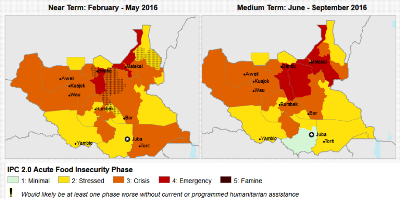Food consumption gaps widen in South Sudan: report
April 14, 2016 (JUBA) – Several households in the northern Greater Upper Nile region will face extreme lack of food and high levels of malnutrition in the lean season period, Famine Early Warning Systems Network (FEWS NET), a leading provider of early warning and analysis on food insecurity, warned in its latest findings.

About million people have been displaced by the conflict in the young nation, with close to 200,000 living in protection sites of the United Nations mission in the country.
According to the FEWS NET, shortage of foreign currency and consistent depreciation of the South Sudanese Pound makes importation of food commodities difficult.
The South Sudanese Pound further depreciated from 21.6 SSP/USD in mid-March to 32.2 SSP/USD on April 1st, further reducing the purchasing capacity of urban households.
“In the face of restricted supply of foreign exchange and depreciation of the South Sudanese Pound, local food prices continue to increase, constraining household market access,” reads the report, which Sudan Tribune obtained.
The decision by the Sudan government to open its border with South Sudan, the report says, saw several people from Northern Bahr el Ghazal migrate to Sudan in search of income-earning opportunities and greater food access.
Increased migration from Eastern Equatoria to Uganda and Kenya was also reported in March, according to the report.
Last week, an assessment by two UN agencies revealed that civil strife and unfavourable rains have further reduced crop production in South Sudan, contributing to a cereal deficit of 381,000 metric tons – 53% greater than in 2015 – and aggravating the already severe food shortages.
The crisis in South Sudan is marked by alarming levels of hunger. Currently, nearly half of the country’s population, are unsure where their next meal will come from, while the rate of severe food insecurity has now reached 12%, double the rate of a year ago.
South Sudan has over 90% of arable land for agriculture, but has utilised only about 4.5% of it since 2011, despite the huge agricultural production potential. More than 80% of the South Sudanese population depend on agriculture as a source of livelihood.
(ST)
